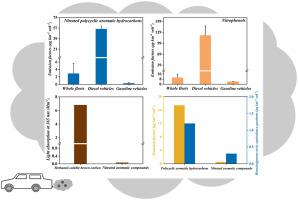Environmental Pollution ( IF 7.6 ) Pub Date : 2022-09-01 , DOI: 10.1016/j.envpol.2022.120070 Runqi Zhang 1 , Sheng Li 1 , Xuewei Fu 1 , Chenglei Pei 2 , Jun Wang 1 , Zhenfeng Wu 1 , Shaoxuan Xiao 1 , Xiaoqing Huang 1 , Jianqiang Zeng 1 , Wei Song 3 , Yanli Zhang 4 , Xinhui Bi 3 , Xinming Wang 5

|
Vehicle emissions are an important source of nitrated aromatic compounds (NACs) in particulate size smaller 2.5 μm (PM2.5), which adversely affect human health and biodiversity, especially in urban areas. In this study, filter-based PM2.5 samples were collected during October 14–19, 2019, in a busy urban tunnel (approximately 35,000 vehicles per day) in south China to identify PM2.5-bound NACs. Among them, 2,8-dinitrodibenzothiophene, 3-nitrodibenzofuran and 2-nitrodibenzothiophene were the most abundant nitrated polycyclic aromatic hydrocarbons (NPAHs), while 2-methyl-4-nitrophenol, 2,4-dinitrophenol, 3-methyl-4-nitrophenol and 4-nitrophenol were the most abundant nitrophenols (NPs). The observed mean fleet emission factors (EFs) of NPAHs and NPs were 2.2 ± 2.1 and 7.7 ± 4.1 μg km−1, and were 2.9 ± 2.7 and 10.2 ± 5.4 μg km−1 if excluding electric and liquefied petroleum gas vehicles, respectively. Regression analysis revealed that diesel vehicles (DVs) had NPAH-EFs (55.3 ± 5.3 μg km−1) approximately 180 times higher than gasoline vehicles (GVs) (0.3 ± 0.2 μg km−1), and NP-EFs (120.6 ± 25.8 μg km−1) approximately 30 times higher than GVs (4.1 ± 0.2 μg km−1), and thus 89% NPAH emissions and 56% NP emissions from the onroad fleets were contributed by DVs although DVs only accounted for 3.3% in the fleets. Methanol solution-based light absorption measurements demonstrated that the mean incremental light absorption for methanol-soluble brown carbon at 365 nm was 6.8 ± 2.2 Mm−1, of which the 44 detected NACs only contributed about 1%. The mean EF of the 7 toxic NACs was approximately 3% that of the 16 priority PAHs; However, their benzo(a)pyrene toxic equivalence quotients (TEQBaP) could reach over 25% that of the PAHs. Moreover, 6-nitrochrysene mainly from DVs contributed 93% of the total TEQBaP of the NACs. This study demonstrated that enhancing DV emission control in urban areas could benefit the reduction of exposure to air toxins such as 6-nitrochrysene.







































 京公网安备 11010802027423号
京公网安备 11010802027423号